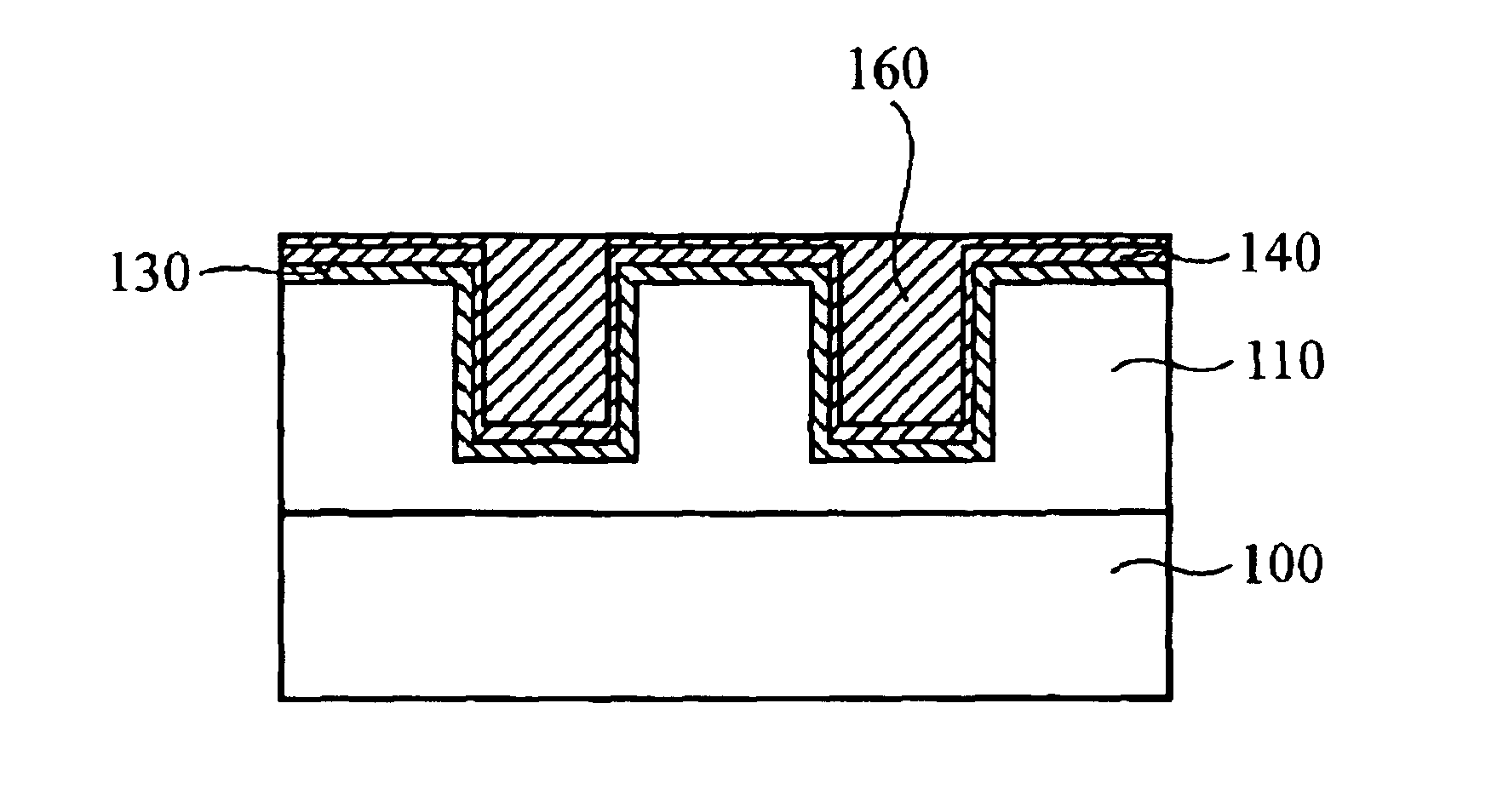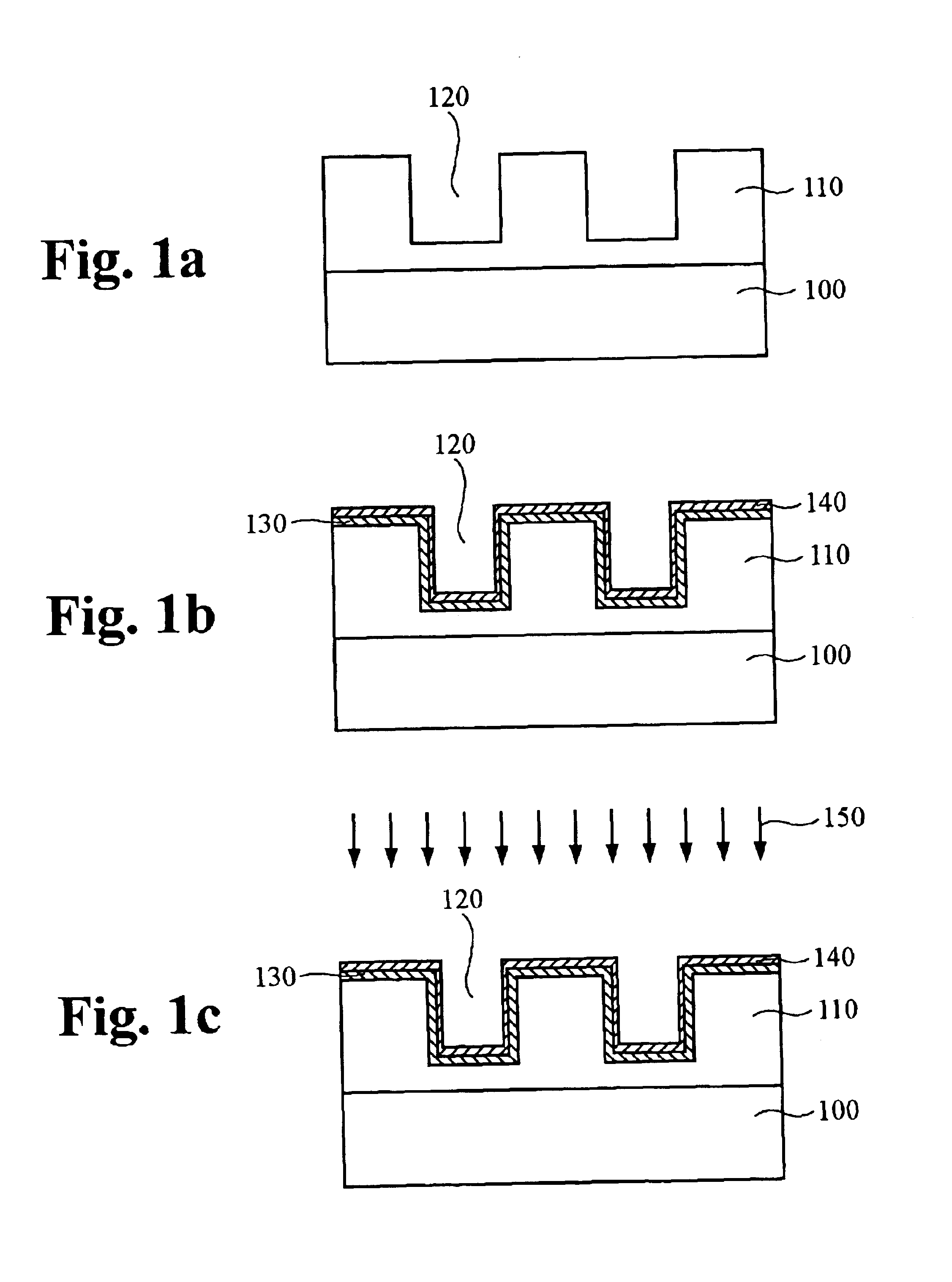Method of forming copper interconnections and thin films using chemical vapor deposition with catalyst
a technology catalyst, which is applied in the direction of chemical vapor deposition coating, semiconductor/solid-state device details, coatings, etc., can solve the problems of aluminum alloys being weak, the failure mechanism known as electromigration problems, and the grain size of aluminum alloys becoming more serious concerns
- Summary
- Abstract
- Description
- Claims
- Application Information
AI Technical Summary
Benefits of technology
Problems solved by technology
Method used
Image
Examples
embodiment 1
Preferred Embodiment 1
A method of forming interconnecting conductors such as trenches, via holes, contacts using copper material by means of a copper chemical vapor deposition(CVD) process using catalyst is disclosed and described below in detail.
First step is preparation of samples. FIG. 1a shows a damascene structure by etching a hole 120 in an insulating layer 110 or the silicon substrate 100. This is a typical damascene structure. The top opening of a hole 120 is 500 nm in width and the aspect ratio is 2:1, (therefore, the depth of the hole 120 is 1000 nm). Referring to FIG. 1b, all surfaces including the hole 120 are covered with tantalum nitride(TaN) film 130 by means of sputtering. This tantalum nitride film acts as a barrier layer that prevents the conducting material 140 from penetrating into the insulating layer 110 during deposition process, where such penetration would, otherwise, alter the basic integrity of the conductor-insulator relationship, thereby defeating the pu...
embodiment 2
Preferred Embodiment 2
Interconnecting conductors imbedded into silicon substrates have many different shapes and sizes. The interconnecting conductors for power and signal applications are generally larger. However, as described in Preferred Embodiment 1 above, the copper fill method based on a copper CVD using catalyst according to the present invention is not well suited for filling a large area where the aspect ratio is very small such as a pad for input / output(I / O) signal and power lines.
Since damascene structures must be used in conjunction with copper deposition method according to the present invention because of the difficulty in etching copper materials unlike other "soft" metals such as aluminum alloys, a large trench with very small aspect ratio must be formed in order to use the copper fill method in accordance with the present invention.
Referring to FIG. 1i, a large trench 192 is formed in an insulating layer 190. However, a copper fill method in accordance with the pre...
embodiment 3
Preferred Embodiment 3
As afore-described in Preferred Embodiment 1, a silicon substrate sample with a barrier layer 230 and a seed layer 240 inside a trench 220 as well as on the top surface referring to FIG. 2a is prepared. In general, a sputtering method is used in forming barrier layer 230 as well as a seed layer 240. However, when the top opening of trenches and via holes are narrow, a CVD method may be used for forming a barrier layer 230 using TaN, or TiN and also a copper CVD method using ethyl-iodide as catalyst may be used for forming a seed layers 240. The copper source material (hfac)Cu(vtms) is again used here the same way as in Preferred Embodiment 1.
The catalyst ethyl-iodide is also applied as shown in FIG. 1c to form an additional copper layer 260 by means of a copper CVD using catalyst, whereby the second copper layer 260 is made thick enough (no more than 100 nm) to be used as an electrode for electroplating on top of the copper layer 260. Completely-filled copper l...
PUM
| Property | Measurement | Unit |
|---|---|---|
| depth | aaaaa | aaaaa |
| width | aaaaa | aaaaa |
| aspect ratio | aaaaa | aaaaa |
Abstract
Description
Claims
Application Information
 Login to View More
Login to View More - R&D
- Intellectual Property
- Life Sciences
- Materials
- Tech Scout
- Unparalleled Data Quality
- Higher Quality Content
- 60% Fewer Hallucinations
Browse by: Latest US Patents, China's latest patents, Technical Efficacy Thesaurus, Application Domain, Technology Topic, Popular Technical Reports.
© 2025 PatSnap. All rights reserved.Legal|Privacy policy|Modern Slavery Act Transparency Statement|Sitemap|About US| Contact US: help@patsnap.com



